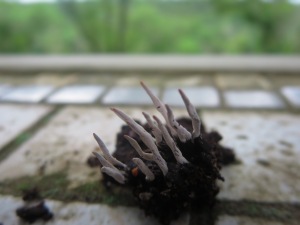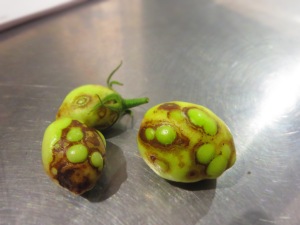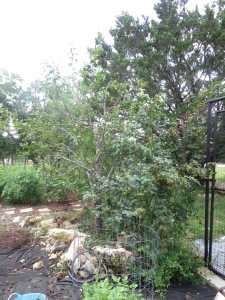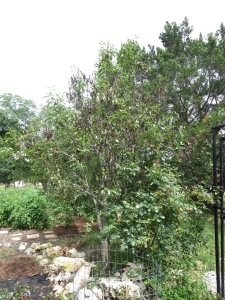Spooky Action Ranch Report | Week Twenty Two 2015
May 25th to May 31st, 2015
Fungus Among Us

I am not sure what kind of mushroom/fungus this is, but I found it growing in the Okra bed. Anyone able to identify it? These little towers are about an inch tall.
We mulch our garden heavily with wood that we build from the tree debris we gather from around the property. This wood often provides a very fertile locale for the growth of a wide assortment of fungus, especially when the weather has been as wet and cool as it is this season. Fungi perform an essential role in the decomposition of organic matter and have fundamental roles in nutrient cycling and exchange. For this reason, we welcome the fungus, who are greatly important to the health and well being of our soil community. (although there are some fungal diseases which can cause problems in food crops). A majority of plants have actually developed a symbiotic relationship with fungus dating back hundreds of millions of years, and the relationship helps the plants absorb inorganic compounds from the soil.
The importance of fungal systems to the life of plants is one of the reasons that natural and organic farming techniques recommend using a low or no till technique for garden cultivation. Tilling can disrupt the microbial networks in the soil and ruin the fungal life, which can cause collapse of the ecosystem. Hobby Farms has a very interesting article about No-Till Farming and the sorts of mulches and techniques to use. One of the things we will be looking at closely this season is our own use of wood much, which may actually be leaching more nutrients from the soil than we would want, since the actual process of decomposing wood can lock nutrients in a form that is unavailable to the green plants. We will be looking for an alternate mulching solution for next season.

These tomatoes were the first sign of a stink bug problem. The adult bugs mostly feed on the fruits and cause damage to the fruit which can effect both flavor and texture.
Stink Bugs
This is the first year we have encountered these little pests and as the name suggests, boy do they stink, and I am not just referring to the smell. We first noticed them due to damage on our tomato plants. These bugs are not particularly discriminant eaters, however, and they will gladly dine on just about anything in the garden. They produce a foul smelling defensive spray which they deploy when they feel in danger. This is a great defense mechanism for them as many or most birds will immediately drop the bug when confronted with the horrid taste. Unfortunately, this means that natural predators of the bug are few and far between. There are parasitic wasps and a few other of the good bugs, but if a large adult population develops, it can be really difficult to combat the infestation. The nymphs, however, are much more vulnerable, and since the bug can produce up to four generations in a single year, its best to wipe the nymphs out whenever you can.
We have been focusing on hand picking the adult bugs, since there are no really good organic measures to take against them, but I have sprayed soapy water on the nymphs when I find them. This does seem to do the trick. Do be warned, if you are going to hand pick, and subsequently crush, the adults, they will stink on you and the stink juice stains. I highly recommend you wear gloves. If you do crush them bare handed, as I did once, the stink will wash off but the stain will stay for several days, like a dark brown ink on your skin.
If you would like to learn some more about the Stink Bug, there is a nice article over at Plow and Hearth. They sell a few products to help manage stink bugs, mostly by the trap method. I haven’t tried this, but I think if I continue to see them into the winter season, I might give one of these products a chance.
Fire Blight on the Pear Tree
The cool and wet spring may have also introduced another very unwelcome guest into the garden in the form of fire blight on our pear tree. Fire blight is a bacterial infection which is, most sadly, spread by bees into the blossoms of the fruiting tree. The bacteria may not always get in deep enough to the blossom to cause an infection, but with the addition of rain, it can get washed more deeply into the blossom and an infestation can begin. There is no really great way to treat the infection once it has gotten into the tree and the only way to save the tree is to cut off the infected areas before any of the infection can get into the root stock. Our pear tree will be getting a serious trim and we will need to watch it for the rest of the season and be certain that we remove any limbs that show signs of disease.
I first noticed damage probably almost a month ago, just after the tree flowered. At that time, the blossoms seemed to wilt and die back, but since I had never encountered this before, I was not sure what was happening. I thought, ‘maybe they just didn’t get pollinated.’ I could not have been more wrong and not taking more immediate action when I saw the damage may end up costing me this tree. The cuts I will need to make now that the infection has progressed will be much more serious and will greatly stress the tree, where I might have been able to stop the progress of the disease without such drastic trimming if I had acted sooner.

After the trim. You can see that a very large percentage of the tree’s growth has been removed, including the central leader of the tree and some larger old growth. There is a risk that so much loss of limb and greenery will be too stressful for the tree, but since the infection itself could be deadly if it spread to the core of the tree, I felt extreme measures were called for.
What I learned from this is that a ‘hmm, well, let’s wait and see.’ attitude toward changes in the plants in the garden is not the best policy. I should trust my gut and investigate if I think that something is amiss. I will employ this new philosophy moving forward and work to bring my action closer to the time of the event, or possibly even look to being proactive in my garden, tree, and shrub care.


0 Comments
Trackbacks/Pingbacks